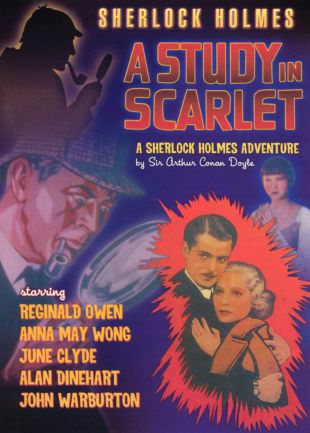
In spite of being named for the very first Sherlock Holmes novel, A Study in Scarlet, the 1933 film only utilizes its title and a few character names. The plot is, in other words, entirely original, leading me to imagine the producers felt they needed the name recognition more than the story. While it seems a little odd, particularly as I don’t recall any study in scarlet in the movie, I can’t really complain though, as the source is not a favorite of mine.
The story concerns a syndicate of individuals from different walks of life who have formed an inheritance agreement. Each time one of the group die, their property is redistributed to the surviving members of the organization. When several members of the group die in quick succession in suspicious circumstances, the wife of one of the victims asks Sherlock Holmes to investigate.
One of the most frustrating things about this film is that the film introduces some genuinely exciting ideas but seems to have no clue what to do with them. An example of this can be found at the start of the film with the first murder. This takes place within a sealed train compartment, potentially setting up an intriguing locked room problem, but the film never really mentions this again, nor gives a satisfactory explanation for why the death happens in that way. This is unfortunate as it feels that the film could have been more focused on some of the details of these crimes, but there is a sense that we are just racing to get to our last few possible victims.
Similarly, I was really struck by the use of a certain nursery rhyme tied to the deaths, several years before And Then There Were None was written and used the same technique. There is even an incident in the film that parallels a really important plot point from that story. It is fascinating to wonder if Christie ever saw this film. If she did, she certainly improved on the way those elements are used here however as it feels there is a lot of untapped potential in its setup.
While it fails to grasp the potential of some of its story elements, other factors also play their part in weighing this down. I think particularly of the identity of the villains, who stand out so much it feels obvious. Though one aspect of the denouement surprised me, the bulk of the film feels like it treads expected territory, reducing the punchiness of that moment.
It is at this point that I have to acknowledge the elephant in the room, namely that the film is in really terrible shape. As often seems to be the case with small and independent studios of this period, it seems that their cannisters were not handled with care. This is a shame but it is not unexpected for films from this period. While the juddery, soft picture may be a big problem for some viewers, I took more issue with the often tinny, indistinct sound which makes some lines of dialog hard to follow. Of course, some performers’ enthusiastic accent work doesn’t help much with that either.
Turning to the cast, Reginald Owen takes the leading part of Holmes are is – just fine. Physically robust, he comes over as stolid rather than possessing any great energy, and there is not much flair in his deductive process. There are however a few typically Holmesian touches, most notably a lengthy sequence in which he investigates while in disguise, but compared with other iterations of the character, this feels quite forgettable.
Warburton Gamble provides some support as Watson, though as his lines are frequently the least audible, I didn’t get a strong read on his interpretation of the character. He is given little to do beyond carry his revolver though, suggesting it is not likely that hearing him better would make all that great a difference to my read of him. Alan Mowbray provides further support as ‘Lastrade’, the curious spelling of the character’s name leaving me questioning whether this was clunky misspelling or an attempt to avoid usage rights for the character. Either way, Mowbray is fine but lacks strong personality in the role.
Which brings me to my reason for picking out this particular Holmes film, Anna May Wong. Here she is called on to play British, leading to a game if only partly successful attempt to mask her accent. Although she is on screen for only a small portion of its running time (maybe ten minutes at most), she is always compelling when she is. I wish her part had been a little more substantial and given her more opportunity to perform, but even as presented she is one of the few largely successful elements of the picture.
As much as I wish I could recommend this film, I have to acknowledge that its poor physical condition and sloppy presentation made this a tough watch for me. There are bright spots, not least a key moment in the final confrontation, but it’s hard to escape the feeling that this film had some great ideas it inexplicably chooses to leave on the table. A disappointment.




Leave a comment